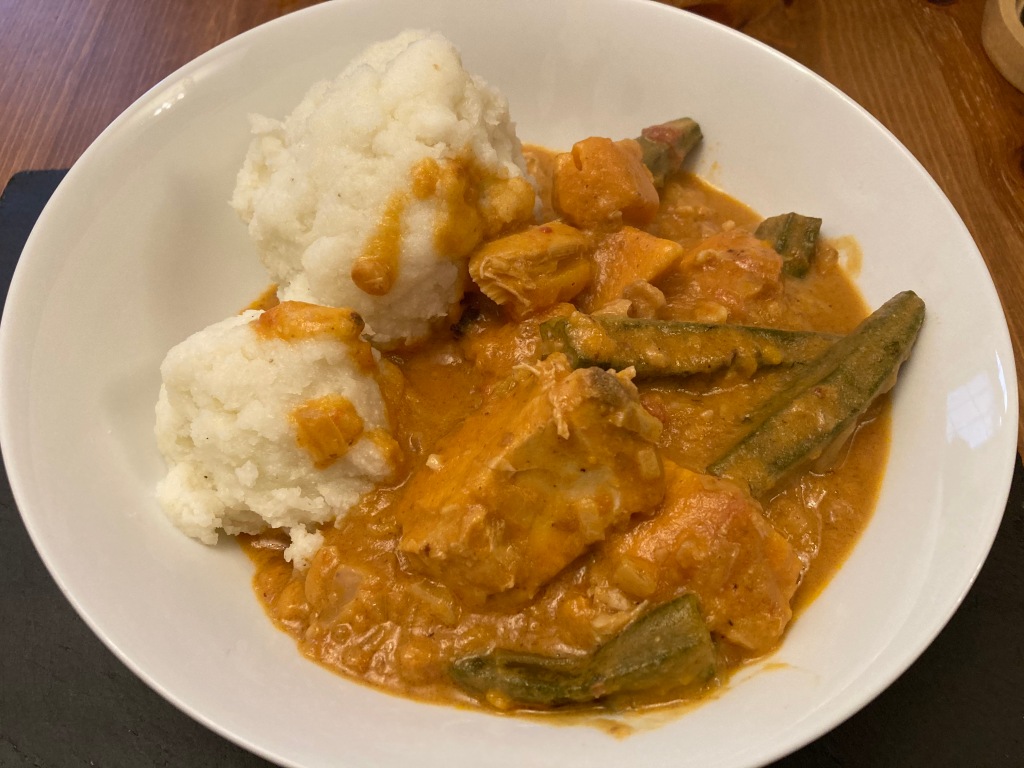Miranda consulted her Zimbabwean colleague when we were choosing this recipe. He admitted to not being much of a cook himself, but suggested that a typical recipe would be a beef (or oxtail) stew with squash and peanuts. ‘Oh good,’ we thought. ‘Another beef stew.’ However, then we came across a recipe for huku ne dovi, a ceremonial vegetable and peanut stew which, although based on chicken rather than beef, fulfilled the peanut requirement and came close enough to including squash (with sweet potato and turnip). The chicken was apparently optional, because it is only brought out for feasts in Zimbabwe (due to it being expensive), but having learnt from Miranda’s colleague that meat is plentiful and therefore commonly eaten in Zimbabwe, we thought we should include it.
In preparation, we dutifully added the ingredients to our online grocery order, only to find on delivery that the 2 turnips listed in the recipe weren’t available (no substitutions). Miranda mentioned this to her Zimbabwean friend, who said that although there can be a lot of vegetables in Zimbabwean dishes, he ‘never came across a turnip’ when he lived there – so it was obviously meant to be!
As for the chicken, we weren’t sure how much chicken we would actually need for ‘2-3 cups of chicken’, so decided to buy a whole chicken, which we roasted and then cut up (which also gave us some leftovers). We then used the carcass to make our own chicken stock for the recipe – although this part is obviously optional.
We served this with sadza, which is Zimbabwe’s version of the stiff cornmeal we’ve come to expect with Southern African dishes, with its own particular cooking method. We read somewhere (although can’t remember where) that white cornmeal is preferable to yellow in Zimbabwe, so we tracked down some white cornmeal. There were two to choose from in the shop: a smaller (and therefore cheaper) bag that said it was fortified with vitamins, or a massive bag. The former seemed like the better choices for all three of the reasons just mentioned, until we actually read the label and saw that it contained ‘genetically modified organisms.’ Not entirely comfortable with this idea, we opted for the bigger bag – which means we now need to eat a lot of cornmeal.
Huku ne dovi
Ingredients
2 tbsp olive oil
2 onions, chopped
1 cup peanut butter
4 cups chicken stock
1 tin of chopped tomatoes
Salt and pepper
1/2 tsp cayenne pepper (we left this out to make it toddler-friendly)
2 cups cabbage, finely chopped
3 sweet potatoes, chopped
4 carrots, chopped
(2 turnips, chopped)
12 okra, topped and tailed
2-3 cups chicken, cooked and in big chunks
Method
1. In a large pot, fry the onion in the oil until soft (about 3 minutes).
2. Reduce the heat to medium and stir in 1 cup of the stock.
3. Whisk in the peanut butter, then stir in the rest of the stock, the tomatoes, salt and pepper to taste and cayenne pepper.
4. Bring to a boil, then reduce heat, cover, and let simmer for 30 minutes.
5. Stir in the cabbage, sweet potatoes, carrots and turnips, bring to the boil, then reduce heat again, cover and cook for 20 more minutes.
6. Stir in the okra and chicken chunks, cover and let stew for 30 minutes.
7. Serve with sadza.
Serves 6
Sadza
Ingredients
4 cups water
2 1/2 cups white cornmeal
Method
1. Bring 3 cups of the water to the boil in a large pot.
2. Combine 1 1/2 cups of the cornmeal with the remaining 1 cup of water.
3. Reduce the heat to medium-low and add the cornmeal mixture to the boiling water, stirring constantly with a wooden spoon until it starts bubbling. Let it cook for 10-15 minutes.
4. Start adding the remaining cup of cornmeal, mixing well with a wooden spoon (or, like we did, draft in the Bamix because the wooden spoon isn’t going to cut it).
5. Turn the heat down as low as it will go, then cover and leave to simmer until it pulls away from the sides of the pan.






Well, this made a nice change from beef stew, and the different vegetables in it also made it a bit more varied than some of our other recent dishes. We did find that it’s best served fresh: the leftovers mushed together somewhat when we reheated them, and although that didn’t affect the taste, it did make the texture less interesting. The peanut butter gave a distinctive taste and creaminess, and the cabbage actually served to thicken it as well, as it was so finely chopped it effectively dissolved into the sauce.
Another triumph: Baby Mash actually ate some of it. He’s becoming fussier by the day with food, which apparently is a phase he’ll grow out of, but he’s certainly taking his time. Having been exposed to more flavours in his two years than we probably had in our first ten, he doesn’t know how lucky he is – but we digress. We’d spent some time before the meal showing him pictures of Zimbabwe and showing him where it is on the world map we have on our wall (not that he has any comprehension of what that means), and during the meal we played some Zimbabwean music. Well, either that piqued his interest or he thought he should show some appreciation for his parents’ cooking for once, but he nibbled on a bit of sadza and tried one piece of sweet potato – so we counted that as a win.
